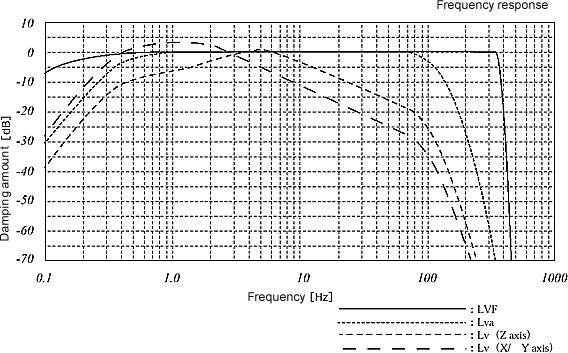

The VR-6100 Vibration Level Meter measures the vibration level evaluation amounts of wide range of measurement applications or various vibration sources. So, it is possible to calculate various evaluation amount of vibration level or vibration acceleration level of time rate level, power average value, power total value, maximum/minimum value or waveform peak value in the 3 axes at the same time. Contents and quantifier of each evaluation amounts are as follows.
Vibration level (Lv)
The vibration level (Lv) is 20 times of the common logarithms of the value which is applied the weighting based on vibration sensation characteristic (vertical and horizontal) and dynamic characteristic (630 msec) specified in JIS C1510-1995 to the effective acceleration value and divided with the reverence value (10-5 m/s2). The unit is dB.
a: Effective value of vibration acceleration
which is processed with a weighting of vibration sensation |
Vibration acceleration level (Lva)
The vibration acceleration level (Lva) is the value which is without weighting of vibration sensation (JIS C1510-1995 flat characteristic is used) and divided into level.
Overview of weighting of vibration sensation characteristic
The human sense of feeling vibration is relied on a frequency, and it depends on directions (vertical and horizontal). The VR-6100 is possible to switch the characteristic in accordance to use, such as the weighting of vibration sensation characteristic (Vertical characteristic, Horizontal characteristic) by the frequency specified in the JIS C1510-1995, or flat characteristic without weighting. The measured value with a weighting of human vibration sensation is called vibration level, and without weighting of human vibration sensation is called vibration acceleration level, respectively.
The frequency range is specified as 1 Hz to 80 Hz in the JIS C1510-1995, and vibrations except for this range are limited by the band. However, the VR-6100 has an original characteristic setting that the frequency band of 1 Hz to 315 Hz becomes flat. Therefore, the measurement of the frequency vibration is possible not only with the range which are specified in the JIS C1510-1995, but also with other ranges. In addition, weighting of vibration sensation characteristics in each use are as follows.
| Weighting of vibration sensation characteristic specification | ||
|---|---|---|
| Lv | Vibration level | Vibration sensation (vertical and horizontal) characteristic JIS C1510-1995 |
| Lva | Vibration acceleration level | Vibration sensation (flat) characteristic JIS C 1510-1995 |
| LvF | - |
Flat characteristic which expands frequency range |
Band limit filter
(1) Cutoff frequency 0.4 Hz, second butterworth type high-pass filter (-12 dB/oct)
(2) Cutoff frequency 100 Hz, forth butterworth type low-pass filter (-24dB/oct)
(3) Cutoff frequency 355 Hz, fifth chebyshev type low-pass filter (-30 dB/oct)
In addition, the frequencies are limited with the filter (1) and (2) in the use of Lv and Lva, and with the filter (1) and (3) in the use of LvF.

Power average level (Leq)
The power average level (Leq) is the vibration level or vibration acceleration level of the stationary vibration, which has same energy when the vibration level is fluctuated dramatically within the measurement time. The evaluation quantity of the power average level is corresponded to the equivalent continuous sound level of the sound level meter.
Power total value (LE)
Power total value (LE) is the vibration level or vibration acceleration level of stationary vibration within the duration time of 1 second which has same energy as the vibration within the measurement time. The evaluation quantity of the power total value is corresponded to the single noise exposure level of sound level meter.
Maximum value (LMX)
Maximum value (LMX) is the maximum value of vibration level or vibration acceleration level that is sampled within the measurement time. The measurement method which is described in the JIS Z8735-1981 vibration level is to measure the average value of maximum value in each fluctuation, when the indication value is fluctuated periodically or intermittently.
Minimum value (LMN)
Minimum value (LMN) is the minimum value of vibration level or vibration acceleration level that is sampled within the measurement time.
Waveform peak value (LPK)
Time ratio level (LX)
Revised:2002/04/12